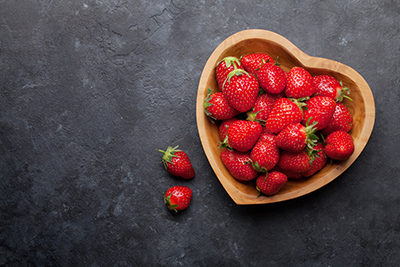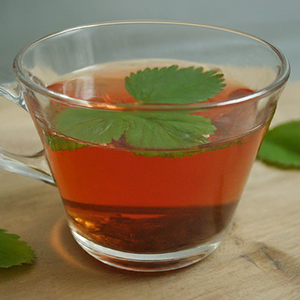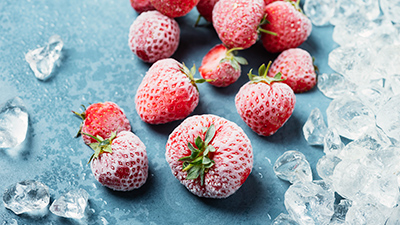Contents
The numerous strawberry health benefits are well-known all over the world. Strawberries are grown worldwide and are an excellent example of the symbiosis of two worlds. They share the benefits found on either side of the Atlantic. European explorers introduced American varieties to Europe, which were crossed with OLD WORLD varieties.
The European strawberry is more petite, daintier, and aromatic than the American variety, which is larger and more resistant but less sweet. The types cultivated today combine, successfully, the aroma of European strawberries with the size and resistance of the American varieties.

Strawberry Nutritional Facts
Strawberry’s calorie content is amongst the lowest among fruits, lower even than melons or watermelon. Its fat, protein, and sodium content are also shallow. Sugars are the most critical nutrient in strawberries, with modest amounts of vitamin C, folates, potassium, and iron, which amount to about five percent of their weight.
Strawberries are a reliable source of dietary fiber: One hundred grams supplies 2.3 grams of fiber, representing about one-tenth of an adult’s RDA (Recommended Dietary Allowance). Although strawberries contain various organic acids, such as salicylic acid (a forerunner to aspirin) and oxalic acid, their metabolic impact is alkalizing.
The strawberry’s color comes from vegetable pigments known as ANTHOCYANIDINs, like bioflavonoids. The anthocyanidins found in certain fruits, such as strawberries, act as powerful antioxidants, lowering cholesterol synthesis in the liver.
A study at Tufts University in Boston demonstrated that strawberries have the most significant antioxidant capability of any fruit, followed by grapes, plums, and oranges. The antioxidant effect of fruit was estimated in terms of its capacity to neutralize oxidizing FREE RADICALS. These hostile molecules may be created within the cells as byproducts of metabolic activity or by external pollutants such as tobacco smoke. Free radicals foster lipoprotein oxidation, arteriosclerosis, premature cellular aging, and even carcinogenic mutations. Strawberries’ antioxidant capacity is due to their vitamin C, bioflavonoid, and anthocyanidin content.
Strawberry Health Benefits

Strawberries’ composition and their antioxidant and alkalizing properties make them particularly indicated in the following cases:
Arteriosclerosis – Because of their excellent antioxidant ability, which neutralizes the impact of free radicals, strawberries are a valuable means of preventing arteriosclerosis (the accumulation of cholesterol on artery walls, which later solidify and narrow). Strawberries also promote arterial health by lacking sodium and fat and their opulence in potassium, a mineral that prevents high blood pressure.
Eating strawberries consistently throughout the spring and the first summer months helps avoid arteriosclerosis and prevents further progress. Strawberries should be integrated into the diet of individuals who have suffered angina pectoris or heart attack and when there is poor circulation to the cerebral arteries or those of the lower limbs.
Excess uric acid—Strawberries are diuretics (they increase urine production) and facilitate the elimination of uric acid in the urine. Because of this, strawberries are suggested in cases of uric arthritis and gout.
Constipation – Because of their richness in soluble vegetable fiber, strawberries expedite the passage of feces through the intestines. They also decongest arterial circulation in the portal system (veins in the bowel). Therefore, they are beneficial in cases of hemorrhoids, ascites (fluid in the abdomen), and liver ailments such as chronic hepatitis and cirrhosis.

Strawberry Scientific Facts
- Scientific Name – Fragaria vesca L.
- Related Species – Fragaria virginiana Duch., Fragaria chiloensis Duch.
- French – Fraise [sauvage].
- Spanish – Fresa, frutilla.
- German – Erdbeer.
- Description – False fruit of the strawberry plant or related species of the botanical family Rosaceae. The actual fruits are the small grains clinging to the surface of the strawberry, which comprises the seeds. The strawberry is, in truth, a fleshy thalamus produced in flowers by the merger of the male and female.
- Environment – Strawberries are grown in sandy temperate regions around the world. The United States, Spain, and Japan are the primary producing nations. They are also growing wild in the mountainous areas of Europe and America.
Salicylic and Oxalic Acids
Strawberries have two potential shortcomings:
- Strawberry’s salicylic acid content can cause allergic reactions, usually itching and a skin rash. Individuals allergic to aspirin tend to be allergic to strawberries and vice versa.
- Kidney stones – Individuals who tend to form oxalic kidney stones should avoid eating copious quantities of strawberries. This is because of their oxalic acid content, which includes calcium oxalate, an insoluble substance that forms calculi (stones) when eliminated through the urine. However, investigators believe that moderate strawberry consumption poses no risk to those with kidney stones.
How to Use And Prepare Strawberries

- Fresh – Fresh strawberries should be washed just before eating. They go well with orange juice, apples, yogurt, and grains.
- Strawberry shake – This is made by blending strawberries with orange juice, milk, nonfat milk, or soy beverage.
- Jam and compote – Strawberries are prepared to retain all their nutrients and functional elements, although they lose vitamin C. They signify a means of having them accessible out of season, with an exceedingly high sugar content (around fifty percent).
- Frozen – Frozen strawberries are immensely popular since they make the fruit available year-round and virtually everywhere. Frozen strawberries contain less added sugar (0 to 20 percent) than jam and retain most nutrients and active elements, including vitamin C.
DISCLAIMER: All content on this website is presented solely for educational and informational objectives. Do not rely on the information provided as a replacement for advice, diagnosis, or treatment from a qualified medical expert. If you are pregnant, nursing, or have any preexisting medical concerns, talk to your doctor before using any herbal or natural medicines.
REFERENCES
- George D. Pamplona-Roger, M.D. “Encyclopedia of Foods and Their Healing Power.” George D. Pamplona-Roger, M.D. Encyclopedia of Foods and Their Healing Power. Trans. Annette Melgosa. Vol. 2. Chai Wan: Editorial Safeliz, 2005. 103, 104. Print.
- Medical News Today: https://www.medicalnewstoday.com/articles/strawberries
- PubMed: https://pubmed.ncbi.nlm.nih.gov/27172913/
- MSU Extension: https://www.canr.msu.edu/news/why_strawberries
Last update on 2025-06-03 / Affiliate links / Images from Amazon Product Advertising API





